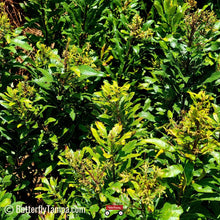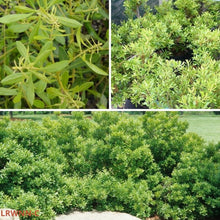Wax Myrtle (Morella cerifera) is an erect, multi-trunked evergreen understory shrub. Found along the Coastal Plain from southern New Jersey to Florida and west along the Gulf Coastal Plain to eastern Texas and southeast Oklahoma, Wax Myrtle is an early successional species that is highly adaptable to a range of conditions: it can be found growing in fresh to slightly brackish banks and shores; pine flatwoods; marshes; wet prairies; hammocks; swamps; and dry xeric uplands.
The shrub is clonal and spreads via underground runners; in its native habitats, In landscaped areas, Wax Myrtle can be pruned and maintained as a privacy hedge. The plant is symbiotic with bacteria that fixes nitrogen from air. Wax Myrtle consequently tolerates poor soils extremely well. It can also tolerate some salt-spray, hurricane-strength winds, soil moisture levels that range from very wet to very dry (once established) and shade. (Plants grown in full sun will be denser than those grown in shade.)
This plant’s tiny, fragrant white flowers provide nectar for bees and butterflies in spring. Its silvery-gray fruit is an energy-rich food source for more than 40 species of birds, including the Northern Bobwhite, Wild Turkey, and the Yellow-rumped (“Myrtle”) Warbler in the late fall and winter. Its seeds are an important food for tree sparrows and Carolina wrens. Additionally, Wax Myrtle is a caterpillar food source for Red-banded Hairstreaks, Bayberry Leaftier Moths, Cecropia Moths, Io Moths, Polyphemus Moths, and the Little Wife Underwing Moths.
Wax Myrtle berries have been used for hundreds of years to make bayberry candles, soaps, and sealing wax. Berries are edible and leaves are purported to make an excellent insect repellant. Leaves can also be used to flavor soups and stews and to make tea.
Native peoples used various parts of the plant for medicinal purposes. As examples, Choctaw used a decoction of leaves and stems to treat fevers and a decoction of roots to treat inflamed roots. Koasati used a root decoction to treat stomachaches. Micmac used roots to treat inflammations. (For more examples, please search this database.) Modern medicine recently demonstrated that Wax Myrtle has compounds that exhibit cytotoxic activities against leukemia, lung and breast cancer cell lines.
Wax Myrtle pairs well with Cabbage Palm (Sabal palmetto), Dahoon Holly (Ilex cassine), Sawgrass (Cladium jamaicensis), Muhly Grass (Muhlenbergia capillaris), Beard Grass (Andropogon virginicus), Saltbush (Baccharis halimifolia), and Myrsine (Myrsine cubana).
Please note: Wax Myrtle has a high flammability fire risk rating — the leaves, stems, and branches contain flammable aromatic compounds. As a result, you should not plant Wax Myrtle within the defensible zone around your home.
/djs






